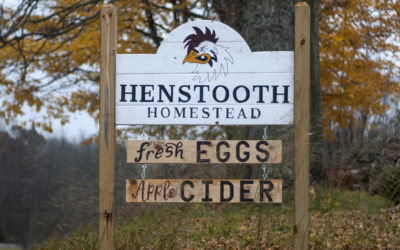Garlic Grove
first year garlicHowever, you should be warned that every dish coming out of that kitchen revolves around two essentials: onions and garlic.
I love, love using them to the point I even made onion jam – which is delicious. With our first year garden fails behind us, it was time to take on a new venture this fall: growing garlic.


The order arrived around the same time we were planning to transplants blueberries and the rains hit hard. It turned our clay–based soil into a slimy mix that made me apprehensive we could even grow garlic . I did some research on changing our soil but, like all good things, it took time. I tossed the idea around of adding gypsum, sand, mulch and/or peat moss but also considered whether we should just build raised beds and buy topsoil.
To start, I separated my garlic and counted all the cloves that would need planting, retreated to my office and started calculating. For anyone who knows me, this is laughable because math is not my strong suit. I came to the conclusion I’d need a 9’ x 6’ area. The next day, I roped Rich into meeting me at Menards to make a final decision on soil prep. After much debate and wandering, we finally came to the conclusion that we were going to try to amend the soil. For the money and time, it was our best long term option as we gathered 5 bags of peat moss and headed out the door.
Eagerly, we headed home, where I got to work pouring the bags out in about half the area I had designated earlier and got to work mixing the peat moss in with the rototiller. The results were good! We were actually quite surprised by how much the consistency changed. The next chance I got, I was back to Menards to grab more bags, picking up the last six in stock. I rototilled the rest of the area, working the soil for a couple hours. Finally, it was time to plant. I grabbed some stakes and rope and set out to mark my rows. I made one long string, spanning the 9’ length. I then took my sledge hammer to mark where my holes would be, counting the number of cloves I could fit as I went.
And here’s the shocker…I miscalculated. Told you math was not my strong suit. You guys, I could fit almost all my cloves in ONE 9’ long row. I think I paced around the garden for a good 15 minutes before resetting my rows towards the back corner in a smaller area. I went and found Rich for confirmation I was doing this right, unsure after my first attempt. I showed him my plans, how many cloves and where they would be all placed, rambling 100 miles a minute. He just stood there with that smile…you know the one, and tried to reassure me that it was all fine. I stayed out until dark, carefully planting each of my 84 cloves, covered them with soil, removed my string guide and then covered the area with straw to protect them throughout the winter months.

Things I learned:
ALWAYS (if possible) mark out your area first. It takes some initial time up front but could save you money and time in the end.
And, always try to think of how your immediate solution could help long term. We could have been stuck with huge raised beds, but now we’re making our soil better for future growing. A couple weeks later, I pulled our potatoes to find they had been getting too much water. Next year we’ll probably end up planting them in the newly worked area for better soil conditions.
Now fingers crossed my little garlic grove will take off this spring!
Recently Published
Water Glassing Egg Preservation
Looking to preserve your eggs for use thorughout the winter season? Water Glassing Eggs will keep your fresh eggs for up to 1 year!
Spring Chickens
The countdown to Spring is well underway for farmers, homesteaders and all those anticipating a new batch of chicks! If you’re new to raising baby chicks, most choose to purchase them in the Spring when temperatures begin to rise. This period makes brooding easiest...
A Letter To Our Homestead – 2018
Dear Homestead, Reflecting on 2018 is an arduous task. Our word of the year was coined early on as Mornicopia. It’s that weird place between mourning and coping -- you can read more about that here. In fact, I contemplated not writing our year end post, but it’s only...



